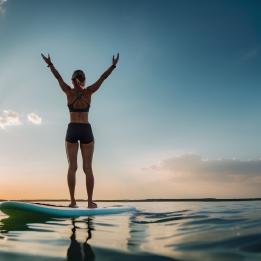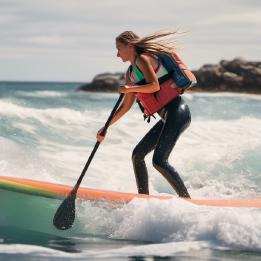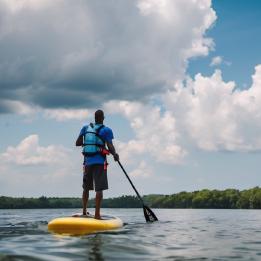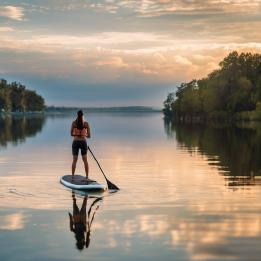Sharing a Stand-Up Paddleboard: Tips for Paddling Tandem
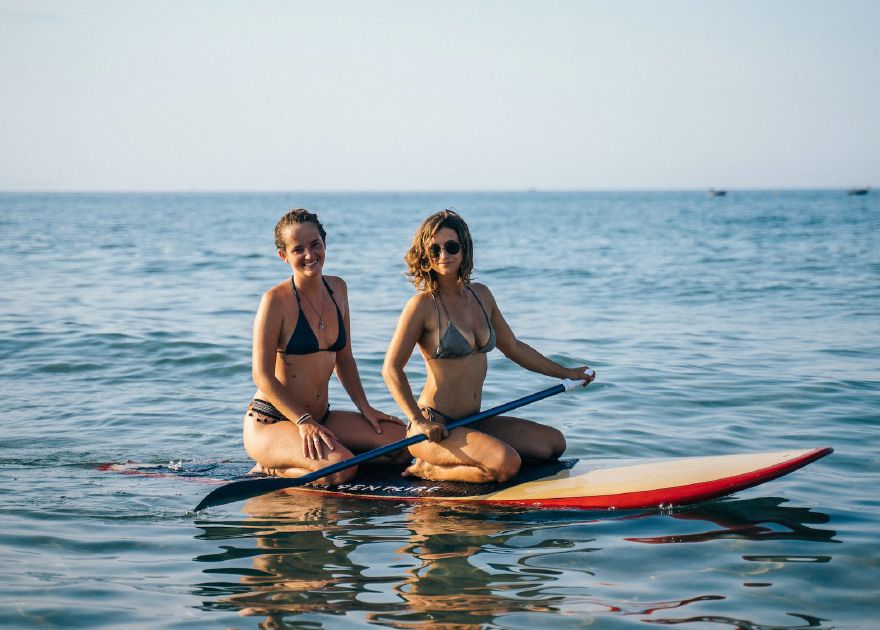
While most people picture SUP as a solo activity, sharing a board with someone else can make it even more enjoyable. If you’re looking for a fun activity to do with your partner, friend or child, you may be wondering – can two people share a SUP?
The answer is yes, tandem SUP is absolutely possible with the right equipment, positioning and communication. Paddling with a companion creates a unique experience where you can explore nature, get some exercise and bond, all while floating on the water together. With stunning surroundings and good company, sharing a SUP is a memorable way to spend quality time together.
The short answer is yes, with the right board and some practice, tandem paddling can be a blast! Here’s what you need to know about sharing a SUP:
Choosing a Board for Two
While it’s possible for two smaller people to balance on a standard 10-12 foot paddleboard, a larger “tandem” board makes sharing a SUP much easier and more comfortable. When selecting a board for two paddlers, there are a few key factors to consider:
- Length – Look for boards that are at least 15 feet long. The extra length provides more space for two people to spread out their stance for balance and paddling. It also improves tracking when paddling straight.
- Width – Aim for boards that are 34-36 inches wide or greater. The wider deck gives a more stable platform to balance the weight of two people. Narrower boards will feel more wobbly.
- Weight capacity – Make sure the board can handle the combined weight of both paddlers plus gear. Look for tandem boards with a capacity of 500 pounds or more.
- Construction – Inflatable boards are a popular choice for tandem paddling thanks to their convenience and durability. Fiberglass boards can also work well but may be heavier.
- Shape – Boards with a flat, square nose help optimize the deck space for two people. Pointed noses can make balancing trickier.
- Padding – A textured deck pad provides traction and makes sitting or kneeling more comfortable over longer paddles.
- Fins – Multiple fins enhance stability and tracking, while single fins are more nimble. Test out different setups.
- Handles – Multiple handles make carrying a larger board easier. Look for boards with 6-8 handles.
Inflatable tandem boards are a popular choice for their convenience, though fiberglass boards can work too if carrying weight isn’t an issue.
Paddling Positions
Finding the ideal paddling positions and arrangements is key to maintaining balance and control of the shared SUP. Be prepared to experiment with different options to see what works best. Consider the following:
- Taller person in back, shorter in front: This classic configuration helps keep the board balanced front-to-back. The taller paddler can steer from the rear.
- Heavier paddler in back: Having more weight in the back adds stability, allowing the lighter paddler to move more freely up front if needed.
- Take turns kneeling and standing: Switching between kneeling and standing paddling gives muscles a break. Just maintain balance during transitions.
- Sit back-to-back: Facing opposite directions and paddling in sync can be an efficient and intimate position. Communicate pace and direction.
- Child in front: Let kids explore up front where you can supervise. Use a child leash and PFD for safety.
- Dog on board: Position smaller pets in front of your feet. Bigger dogs can sit or lay in the middle. Read more about taking dogs paddleboarding.
- Face each other: An advanced position for total coordination. Paddle while maintaining eye contact and conversation.
- Change roles: Trading positions allows both paddlers to steer from the back and set the pace up front. This builds skills.
Get creative with positioning as long as you maintain effective balancing and control. A fun part of tandem paddling is discovering what works best for you.
Communication is Key
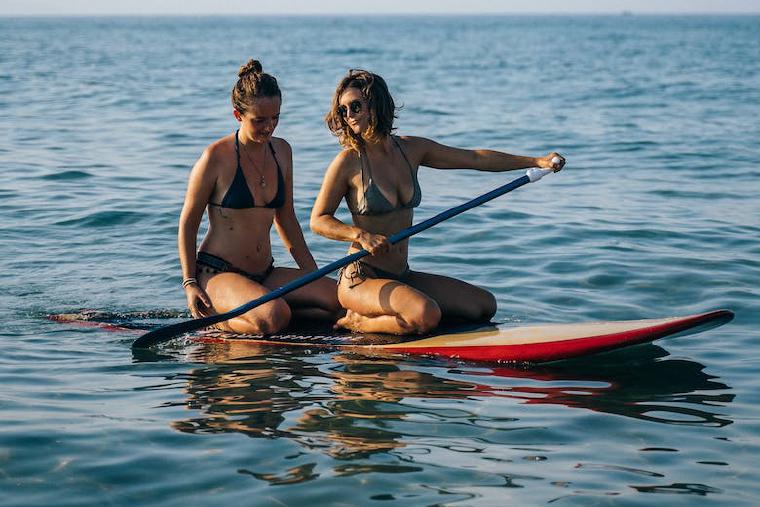
Clear communication between paddling partners is essential for maintaining control and coordination while sharing a SUP. Here are some tips:
- Agree on commands: Set basic commands like “left”, “right”, “stop”, “go”, etc. to use when steering and pacing.
- Make a plan: Before shoving off, discuss who will steer first and the general route. Confirm abilities.
- Announce movements: Say when you need to kneel, stand up, grab something or make any position shifts.
- Give warnings: If you feel off-balance, let your partner know early so you can stabilize together.
- Switch roles: Agree on interval for changing roles between steering and pacing so you both get a chance.
- Find your rhythm: Counting strokes aloud helps match timing. Feel each other’s paddling cadence.
- Have fun! Chat, tell stories and laugh together – this fosters natural chemistry on the board.
Paddling in sync and maintaining course takes cooperation. Chat with your partner to coordinate strokes and steer straight. Getting in a rhythm together takes practice but is part of the bonding experience.
Safety First
Fun as it may be, sharing a paddleboard comes with added risks that require proper safety precautions. Be sure to:
- Wear PFDs – Each person should wear a well-fitted, Coast Guard approved personal flotation device. Inflatable PFDs allow mobility.
- Attach leashes – Each paddler must attach their ankle leash to avoid drifting away if falling off the board.
- Know conditions – Check the weather forecast, wind speed, tides and currents before going out.
- Stay near shore – Until comfortable, new paddlers should stay within easy swimming distance of shore.
- Bring supplies – Pack whistles, water, sun protection and phones or radios in dry bags.
- Buddy system – Keep your partner aware if you start feeling tired, sore or unwell.
- Rescue skills – Learn how to help each other get back on the board after a fall.
- Other boats – Be visible to boat traffic. Avoid areas with large motorized vessels.
- No drugs/alcohol – Balance and judgment are impaired, increasing falling risks.
Taking proper safety gear and being alert to conditions is key to avoiding injuries or emergencies. Paddling with a friend makes it safer, but you must still take responsibility for each other’s wellbeing. Better to call it off early if conditions aren’t right.
Make It a Social Adventure
Paddle boarding with someone else opens up a world of possibilities for quality time and shared adventures. Tandem paddling works great for:
- Romantic outings – Paddle at sunset with your significant other. Bring flowers and snacks for a special evening.
- Family fun – Let kids see wildlife up front while you steer from the back. Bring their toys along.
- Friend time – Bond with friends while getting some exercise. Take turns paddling and chatting.
- Meetups – Join a SUP club or Meetup group for joint paddles. Make new friends who share your hobby.
- Dogs – Let your furry friend ride along, just keep them leashed and take breaks on shore.
- Proposals – Pop the question while floating peacefully or over a romantic picnic.
- SUP parties – Get a massive multi-person board and have a floating event with friends.
- Fitness – Challenge another paddler to paddle faster and race friendly heats.
Paddling with someone makes SUPing more fun and memorable. Sharing the experience also motivates you to get out more often. SUP dates and outings are endless!
Double the Fun on One Board
Stand up paddleboarding alone offers scenery, exercise and peaceful gliding across the water. But sharing a SUP with someone makes the experience exponentially more special. There’s nothing quite like hitting the water together and taking in the sights, paddling in unison, laughing and enjoying each other’s company out in nature.
With clear communication and proper safety precautions, tandem paddling is an incredibly fun way to spend quality time together.
So the answer to “Can Two People Share a SUP?” is a resounding yes! With a large, stable board made for two, intentional positioning, clear communication and proper safety precautions, tandem paddling is an incredibly fun way to spend quality time together. Stay alert, bring supplies and ultimately focus on having an amazing time out on the water with your favorite paddling partner.
